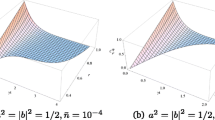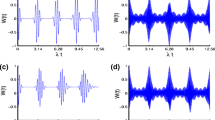Abstract
In this paper, we first introduce Ket–Bra entangled state method to solve master equation of finite-level system, which can convert master equation into Schrödinger-like equation and solve it with the mature methodology of Schrödinger equation. Then, several physical models include a radioactivity damped 2-level atom driven by classical field, a J–C model with cavity damping, a V-type qutrit under amplitude damping and N-qubits open Heisenberg chain have been solved with KBES method. Furthermore, the dynamic evolution and decoherence process of these models are investigated.





Similar content being viewed by others
Explore related subjects
Discover the latest articles, news and stories from top researchers in related subjects.Notes
TFD investigate the dynamic evolution of open quantum system by introducing an extra mode which refers to the environment.
For instance, \(e^{x_{-}\left( t\right) L_{-}}\rho =\sum \nolimits _{n=0}^{\infty }\frac{x_{-}^{n}\left( t\right) L_{-}^{n}}{n!}\rho =\sum \nolimits _{n=0}^{\infty }\frac{x_{-}^{n}\left( t\right) }{n!}\left( \sigma ^{-}\right) ^{n}\rho \left( \sigma ^{+}\right) ^{n}=\rho +\sigma ^{-}\rho \sigma ^{+}\).
Mathematica is a symbolic mathematical computation program, used in many scientific, engineering, mathematical and computing fields. MatrixExp is the order to compute the exponent of matrix.
The comparison may quite trivial because the expression of \(x_{\pm ,z}\left( t\right) \) is complicated; however, this process can be simplified by setting \(n=0\); besides, the comparison between c-number method in Ref. [23] and KBES method is quite simple.
For instance, the Mathematica order MatrixExp[\(\mathscr {F}\)] can immediately obtain the expression of \(e^{\mathscr {F}}\) where \(\mathscr {F}\) is arbitrary-order matrix.
References
Breuer, H.P.: The Theory of Open Quantum System. Oxford University Press, Oxford (2002)
Carmichael, H.J.: Statistical Methods in Quantum Optics 1 Master Equation and Fokker–Planck Equation. Springer Press, New York (2002)
Savage, C.M., Walls, D.F.: Damping of quantum coherence: the master-equation approach. Phys. Rev. A 32, 2316 (1985)
Myatt, C.J., King, B.E., et al.: Decoherence of quantum superpositions through coupling to engineered reservoirs. Nature 403, 269 (2000)
Yu, T., Eberly, J.H.: Finite-time disentanglement via spontaneous emission. Phys. Rev. Lett. 93, 140404 (2004)
Yu, T., Eberly, J.H.: Quantum open system theory: bipartite aspects. Phys. Rev. Lett. 97, 140403 (2006)
Benatti, F., Floreanini, R. (eds.): Irreversible Quantum Dynamics. Lecture Notes in Physics, vol. 622, Springer Press, New York (2003)
Wang, M.C., Uhienbeck, C.E.: On the theory of the Brownian motion II. Rev. Mod. Phys. 17, 323 (1945)
Turchette, Q.A., Myatt, C.J.: Decoherence and decay of motional quantum states of a trapped atom coupled to engineered reservoirs. Phys. Rev. A 62, 053807 (2000)
Kiessich, G., Scholl, E.: Noise enhancement due to quantum coherence in coupled quantum dots. Phys. Rev. Lett. 99, 206602 (2007)
Lax, M.: Quantum noise. X. Density-matrix treatment of field and population-difference fluctuations. Phys. Rev. 157, 213 (1967)
Risken, H.: The Fokker–Planck equation. Springer Press, New York (1984)
Héctor, M.-C.: Decoherence in atom–field interactions: a treatment using superoperator techniques. Phys. Rep. 432(1), 1–41 (2006)
Aréalo-Aguilar, L.M., Moya-Cessa, H.: Solution to the master equation for a quantized cavity mode. Quantum Semiclass. Opt. 10, 671 (1998)
Truax, D.R.: Baker–Campbell–Hausdorff relations and unitarity of SU(2) and SU (1,1) squeeze operators. Phys. Rev. D 31(9), 1988 (1985)
Lu, H.X., Yang, J., Zhang, Y.D., et al.: Algebraic approch to master equations with superoperator generators of SU(1,1) and SU(2) Lie algebras. Phys. Rev. A 67, 024101 (2003)
Verstraete, F., Porras, D., Cirac, J.I.: Density matrix renormalization group and periodic boundary conditions: a quantum information perspective. Phys. Rev. Lett. 93, 227205 (2004)
Celeghini, E., Rasetti, M., Vitiello, G.: Dissipation in quantum field theory. In: Nonlinear Coherent Structures in Physics and Biology, pp. 318–325. Springer Press, Berlin (1991)
Fan, H.Y., Fan, Y.: New representation of thermal states in thermal field dynamics. Phys. Lett. A 246(3), 242–246 (1998)
Verstraete, F., Garcia-Ripoll, J.J., Cirac, J.I.: Matrix product density operators: simulation of finite-temperature and dissipative systems. Phys. Rev. Lett. 93, 207204 (2004)
Perez-Garcia, D., Verstraete, F., Wolf, M.M., et al.: Matrix Product State Representations. arXiv:quant-ph/0608197v2 (2007)
McCulloch, I.P.: From density-matrix renormalization group to matrix product states. J. Stat. Mech. 2007(10), P10014 (2007)
Breuer, H.P., Petruccione, F.: The Theory of Open Quantum System, XXX edn. Oxford University Press, Oxford (2002)
Abdel-Khalek, S., Almalki, M.S.: Entanglement for jaynes cummings model in the presence multi-photon process under decoherence effect. Int. J. Quantum Inf. 3, 1350026 (2014)
Abdel-Khalek, S., Nofal, T.A.: Correlation and entanglement of a three-level atom inside a dissipative cavity. Phys. A Stat. Mech. Appl. 390, 2626–2635 (2011)
Abdel-Khalek, S., Obada, A.-S.F.: New features of Wehrl entropy and Wehrl PD of a single Cooper-pair box placed inside a dissipative cavity. Ann. Phys. 325, 2542–2549 (2010)
Obada, A.-S.F., Abdel-Khalek, S., Shaheen, M.E.: Information dynamics for a non-degenerate two-photon JC model in phase damping cavity. Opt. Int. J. Light Electron Opt. 127, 3266–3270 (2016)
Barnett, S.M., Knight, P.L.: Dissipation in a fundamental model of quantum optical resonance. Phys. Rev. A 33(4), 2444–2448 (1986)
Derkacz, L., Jakóbczyk, L.: Quantum interference and evolution of entanglement in a system of three-level atoms. Phys. Rev. A 74, 032313 (2006)
Ali, M.: Distillability sudden death in qutrit–qutrit systems under amplitude damping. J. Phys. B At. Mol. Opt. Phys. 43, 045504 (2010)
Son, W., Amico, L., Plastina, F., et al.: Quantum instability and edge entanglement in the quasi-long-range order. Phys. Rev. A 79, 022302 (2009)
Popkov, V., Salerno, M., Livi, R.: Full decoherence induced by local fields in open spin chains with strong boundary couplings. New J. Phys. 17, 023066 (2015)
Jordan, P., Wigner, E.P.: About the Pauli exclusion principle. Z. Phys. 47, 631 (1928)
Author information
Authors and Affiliations
Corresponding author
Additional information
Granted by National Natural Science Foundation of China (No. 11574295) and Natural Science Fund of Education Department of Anhui province (No. KJ2016A590).
Rights and permissions
About this article
Cite this article
Ren, YC., Wang, S., Fan, HY. et al. Ket–Bra entangled state method for solving master equation of finite-level system. Quantum Inf Process 16, 270 (2017). https://doi.org/10.1007/s11128-017-1710-z
Received:
Accepted:
Published:
DOI: https://doi.org/10.1007/s11128-017-1710-z




